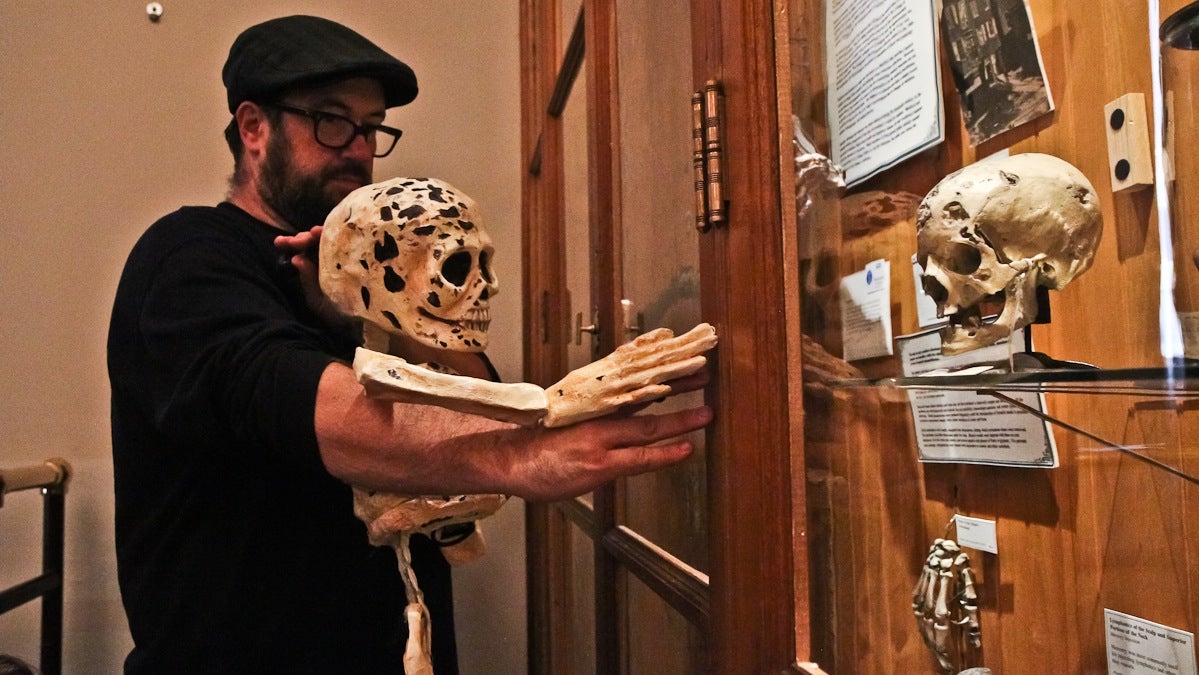Mütter Museum serves as magnet for artists looking for inspiration
Listen
One of the plays opening this weekend during the Philadelphia Fringe Festival is "The Body Lautrec
One of the plays opening this weekend during the Philadelphia Fringe Festival is “The Body Lautrec,” about the famous 19th century French painter, Henri Toulouse Lautrec, and his bones.
It was developed with the cooperation of the Mütter Museum in Philadelphia, a place that attracts the morbidly curious for its vast display of pathological body parts suspended in jars. The 19th century medical science museum is also a magnet for artists looking for inspiration.
“The Body Lautrec” features a series of skeleton puppets representing Lautrec’s bones in various states of distress.
“We would see him as one of these little child skeletons, like in the Mütter, which are so beautiful. Those little child skeletons are so adorable and gorgeous,” said Mary Toumanen, the director. “As a result the puppets that Aaron [Cromie, the co-creator] made are also beautiful. And they suffer all kinds of terrible fates during the course of the show, getting all kinds of bone breaks and corrosions.”
“Don’t give away all the secrets,” scolded Cromie.
“I won’t,” said Toumanen. “All I’ll say is: syphilis.”
Henri Toulouse-Lautrec was the son of aristocratic parents who were also first cousins. Due to inbreeding, he was born with a congenital bone disease that warped his skeleton at an early age. Later in life, as a dedicated carouser of brothels, he contracted syphilis, which wreaked havoc on his already fragile bones.
He was never far from doctors, whom he saw constantly throughout his life. Medicine in the 19th century was still a relatively primitive science. There was a real brutality in the surgery theaters. With no real means of killing pain, doctors with scalpels were torturing patients in their efforts to save them.
The play features a bloody surgical scene, and relationships with doctors that are as intimate as they are conflicted.
“Of course you would have an intense relationship with your doctor, because you’re suffering from a disease that no one knows how to cure, and nobody knows much about,” said Toumanen. “[Syphilis] is such a mysterious disease at this time, it’s terrifying. Of course you cling to your doctor for any shred of hope.”
In 19th century medical science, people with extreme deformities were categorized as “monsters.” That was actually the clinical term for it: a monster. Dr. Thomas Mütter collected hundreds of pathological artifacts in an effort to turn monsters back into people.
Mutter was a specialist in reconstruction surgery to correct gross deformities caused by birth defects, or disease, or injury. He pioneered surgical techniques to that end, but his lasting legacy might be empathy.
His insistence that patients be treated with sterile instruments, and with some form of anesthesia, was resisted by the medical establishment. His colleagues also ridiculed his system of giving a patient a bed (often in a nearby hotel) during recovery from surgery. They were normally scooted out the door as soon as they got off the table.
“He taught generations of medical students to think of the patient not as problems to be solved, but as humans who you are trying to alleviate their suffering, ” said Cristin O’Keefe Aptowicz, author of the new biography Dr. Mütter’s Marvels. “That was a big calling, to alleviate suffering.”
He also insisted that his collection be available for study by artists. When Mütter donated his collection to the College of Physicians of Philadelphia in 1858, artists were on his mind.
“He intended this for scientific study, but the legal documents that supports his legacy state that hours must be appointed to have the museum open for artists,” said museum director Robert Hicks. “So even from the beginning art was in the picture.”
At the time, artists needed the collection of preserved body parts to be able to illustrate anatomy books and sculpt wax models for medical schools. Now, the museum is open to artists of all stripes. Hicks accepts proposals from musicians, filmmakers, performers, fiction writers, and installation artists.
Recent visiting artists include the Brother Quay, a pair of filmmakers who made a poetic documentary about the museum’s artifacts; K.R. Sands, an author who wrote a series of short stories based on the lives behind the artifacts; an Australian artist who studied the 19th century display cases to inspire a her own cabinet of curiosities traveling show.
The Mütter awarded a travel grant to the San Francisco composer Jill Tracy who asked if she could hang out among the artifacts after hours, by herself, just to feel creepy feelings. The resulting song cycle, “The Teratology Lullabies,” will soon be released.
“If the proposal makes sense, we’ll welcome you here,” said Hicks. “You can research anything you want as long as you don’t break anything.”
“The Body Lautrec” is a case in point.
“We want to make a piece about a 19th century syphilitic painter. And they’re all ‘Yes!’ said Toumanen, adding the museum staff eagerly engaged with the story of Henri Toulouse Lautrec and his relationship with the sex trade. “‘You’re going to do prostitution? … you need to know about abortion.’ They are so exciting and game and willing to collaborate with artists. We were like, can we do a show inside the Mütter?…and also people will be nude. And they’re like, Yes! Absolutely! Come on over!”
WHYY is your source for fact-based, in-depth journalism and information. As a nonprofit organization, we rely on financial support from readers like you. Please give today.




